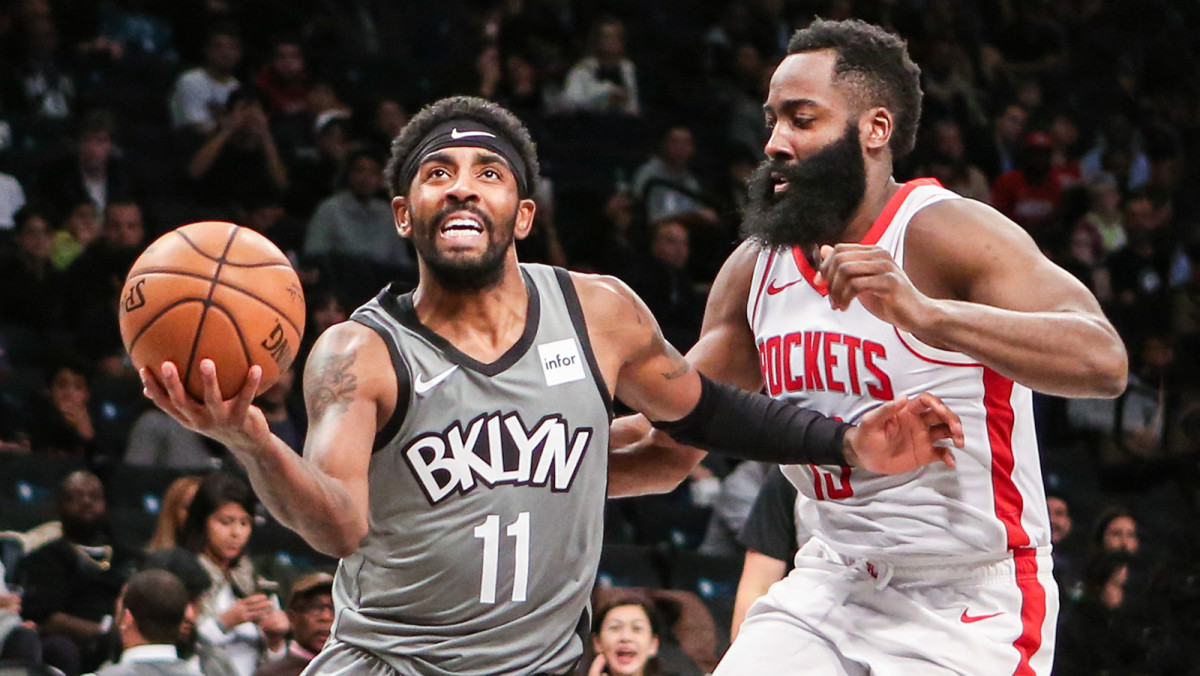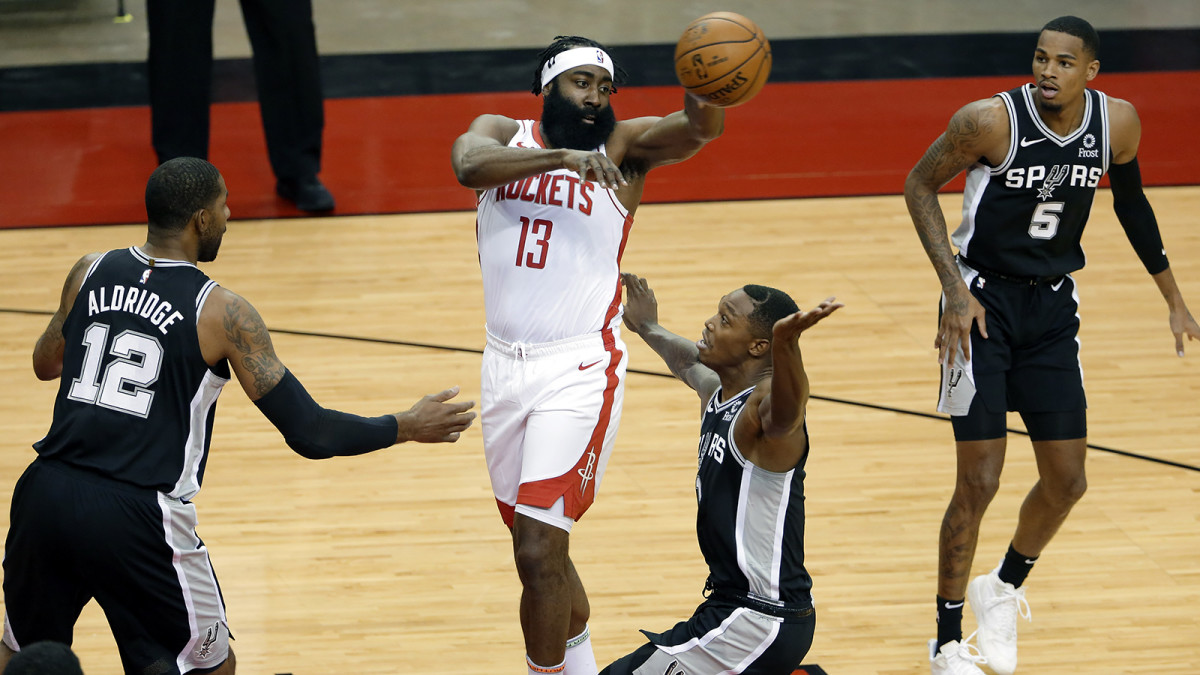Breaking Down James Harden's Fit on the Nets
After a brief hiatus that allowed LeBron James and Anthony Davis to dynamic-duo their way to a league title inside the bubble, the superteam era is once again upon us. The NBA’s latest version was formed on Wednesday afternoon, when the Nets added James Harden to a team that already had Kyrie Irving and Kevin Durant. We’ve never seen three shotmakers this proficient on the same team at the same time. It’s a trio that seems unique and unprecedented for myriad reasons, both good and bad, and how Harden fits with his new teammates has been thrust to the fore as a fascinating question with critical implications.
First, the exciting parts. Durant and Harden are teammates for the first time since 2012, when their Thunder were defeated in the NBA Finals by LeBron’s Heat. Almost a decade later, the pair has a combined four scoring titles (Durant’s first three came while Harden was his teammate), two MVP trophies and a cemented recognition as two historically stellar offensive threats.
If we stopped this article right here, already the Nets would have an unfair advantage against just about everybody they play. Harden and Durant are influential phenomena who demand attention from an entire defensive unit when dribbling the ball. But there’s more: Just off to the side sits Irving, a breathtaking six-time All-Star who’s currently averaging 27 points with 50/42/100 shooting splits. He, too, is irrepressible whenever his team needs a bucket.
On paper, a roster with all three should have no ceiling for stockpiling points. We know this because it’s self-evident—like having to explain why pizza is delicious. But we’ve also already seen Brooklyn’s offense when Irving and Durant play, and it’s a thunderstorm, generating an offensive rating that’d rank second best in the league. Add Harden, a singular force who can either get to the free throw line or his potent stepback three whenever he wants, and the potency of Brooklyn’s three-headed attack is uncut venom.
Not that they should or will adopt the same isolation-heavy style that drove Houston’s success for so many years, but for the sake of conversation let’s just say Brooklyn decided to exclusively lean on Harden’s ability to take games over with an efficiency, usage, and body of work that has no precedent. Defenses would have to play him one-on-one (impossible) or help off Durant and Irving. Imagine those two catching Harden’s kickout pass, driving a closeout, then shredding an opponent that can’t load up to stop them. Teams won’t be able to blitz Harden like the Lakers did in the bubble without being OK that Durant or Irving would then have an open shot or four-on-three advantage. It’d be a slaughterhouse.

Whether they move the ball or pounce from inside their own silos, each one is a natural complement to another; nothing can slow down two of these three at the same time, let alone all of them throughout the course of a seven-game series. Each is a devastatingly accurate three-point shooter who can melt an opponent off the bounce or while standing still.
Spacing won’t be an issue, and they’ll have plenty of it to work in, assuming one of the other two starters is Joe Harris (currently making 54.4 percent of his spot-up attempts), with Landry Shamet (a career 40.2 percent three-point threat coming into this season) and other capable catch-and-shoot options like Timothé Luwawu-Cabarrot and Jeff Green having all the time they need to knock down open shots.
We also don’t know if/when Spencer Dinwiddie will come back, and right now Brooklyn has three open roster spots, with options like Kyle Korver, Ersan Ilyasova and J.R. Smith (*crosses fingers*) technically available. (Rebounders will also be in demand to fill Brooklyn’s vacancies.)
Of course, with Caris LeVert no longer there to fill his overqualified role as a sixth man, Brooklyn’s more fascinating looks won’t be seen until Steve Nash staggers his three superstars, though it remains to be seen exactly who will get to lead second units a majority of the time while the other two rest. Nash started the season with Irving and Durant together every minute they played, but had to pivot after Dinwiddie tore his ACL.

With Harden aboard, Brooklyn could always have at least one of the three on the court. That’s firepower no team in the NBA can match, considering no team has a trio that’s so independently awesome regardless of who’s around them. Together, if everything clicks, their on-court potential is scary. Just consider how any defense would react to Harden and DeAndre Jordan running a high pick-and-roll as Irving sets a flare screen for KD. The answer is they’d be a popsicle inside a microwave. If the Nets don’t finish this season with a top-three offense, something terrible happened.
Speaking of, let’s talk about the more precarious angles of this new partnership. In short, they are: defense, depth, an unparalleled amount of pressure, and, for the Nets, a reality of knowing their success boils down to the whims of three persnickety personalities who have no choice but to coalesce around one basketball in an environment that demands sacrifice and humility. With three of their own first-round picks and four pick swaps now owned by the Houston Rockets, an argument can be made that no team has ever gone all in to win an NBA title quite like the Nets just did.
Taking that colossal bet into account, their ability to get stops may be an issue. Jarrett Allen, their starting center and source of integral rim protection, is now on Irving’s former team, the Cavaliers, and it’ll be interesting to see if/how the Nets replace his impact. Post defense has weaved its way into Harden’s redemption narrative after years of comically aloof effort and awareness, but by itself there’s no evidence that will matter if he isn’t surrounded by other effective defenders who communicate, rotate on a string and instinctually help one another out.
The roster is filled with weak links on that end, and losing Taurean Prince in the four-team transaction didn’t exactly help. Harden is not the shutdown wing they’ll need when matched up against the Celtics, Bucks, or either L.A. team in a playoff series, and it’s easy to envision an opponent running Irving and Harden through ball screens over and over, forcing switches and chaotic mismatches from a group that’s already brittle. Before the Harden Trade 2.0, defense was Brooklyn’s biggest concern. Now it might be its kryptonite, especially if they’ll still close games small with Green at the five.
In comparing this Big 3 with Kevin Garnett, Paul Pierce and Ray Allen; Durant, Steph Curry and Klay Thompson; LeBron, Dwyane Wade and Chris Bosh; or LeBron, Irving, and Kevin Love, there’s always at least one member who’s forced to accept a supplementary role, with fewer touches and a drop in shots. They must bend who they are and embrace the sport’s less glamorous elements without the ball in their hands.
Brooklyn doesn’t have a Love or Bosh or Klay; Harden can be selfless, but will he, after spending his entire prime with the whole show running on his clock? Irving is the least accomplished of the three, with an offensive skill set that overlaps all Harden now brings to the table, but he couldn’t have the defensive impact Bosh did if he wanted, and the praise heaped upon their ability to complement each other earlier in this article turns to ash if one grows unhappy with reduced responsibility.
Assuming bumps in the road given how they’re so similar on the offensive end without lifting each other up on the other side, it’s not too early to wonder if Irving should or will get traded for a superior fit at some point, either this year or next.
And even if Irving is dealt, the short-term pressure to win it all before Harden and Durant either age out of their respective primes or—more likely—enter free agency in July 2022 looking for greener pastures, won't be any less overwhelming. The organization has no future beyond those two. Unlike what the Clippers did two summers ago to acquire Kawhi Leonard and Paul George, this was an all-or-bust gambit that didn’t need to happen. The Nets were already a title contender before this trade. How will that pressure manifest inside a locker room that has no obvious leader? How will it influence decisions made by Sean Marks and Nash? Harden is 31 with a birthday in August and KD is 32 with a birthday in September. Their window won’t be open much longer.
But in the meantime, their collective talent will supersede any fit issues on most nights, against most opponents. If their supporting cast doesn’t work out it can always be reshuffled over the summer, assuming a ring-chasing veteran or two will accept less money than he could otherwise earn.
The Nets have no culture and no obvious on-court identity. Their chosen tempo is as much a question mark as who would have the ball in their hands down two with seconds left in a Game 7. That doesn’t mean they won’t figure everything out, but worthwhile questions can easily become earth-shattering concerns when the stakes get to be as high as Brooklyn just decided to make them.
